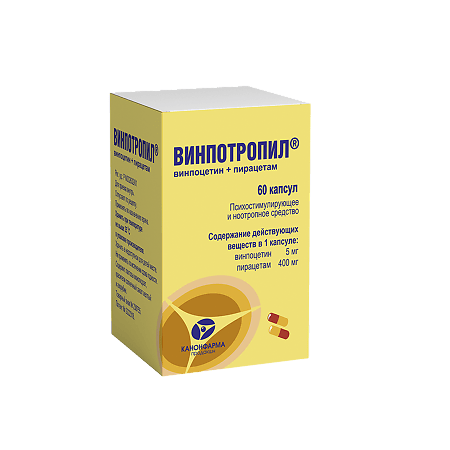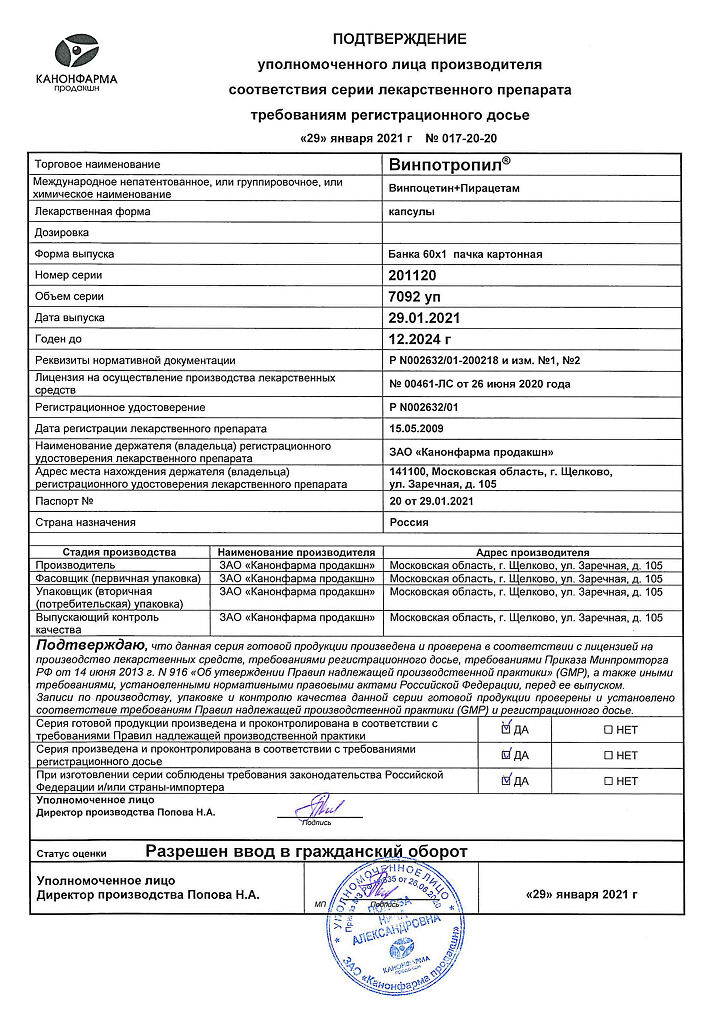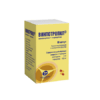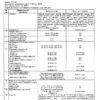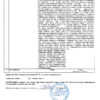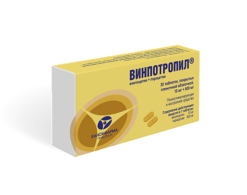No products in the cart.
Vinpotropil, 5 mg+400 mg capsules 60 pcs
€11.05 €9.67
Description
Pharmacodynamics
Vinpotropil is a combined drug. It has properties typical for a psychostimulant (Vinpocetine) and for a nootropic (Vinpocetine, Piracetam).
As a psychostimulant
It improves brain metabolism by increasing glucose and oxygen consumption by brain tissue. Increases resistance of neurons to hypoxia; enhances glucose transport to the brain through the blood-brain barrier; switches the process of glucose breakdown to a more energy-saving aerobic route; selectively blocks Ca2+-dependent phosphodiesterase; increases levels of adenosine monophosphate (AMP), cyclic guanosine monophosphate (cGMP) and adenosine triphosphate (ATP) of the brain. It enhances metabolism of brain noradrenaline and serotonin; stimulates ascending branch of noradrenergic system, has antioxidant effect.
Decreases platelet aggregation and increased blood viscosity; increases red blood cell elasticity and blocks red blood cell utilization of adenosine; helps increase red blood cell oxygen output. Increases cerebral blood flow; reduces cerebral vascular resistance without significant changes in the indices of the systemic circulation.
It does not have the effect of “stealing” and increases the blood supply, especially in the ischemic areas of the brain. It penetrates through the placental barrier.
As a nootropic agent
It has a positive effect on brain metabolic processes, slightly increases the concentration of ATP in the brain, increases the synthesis of ribonucleic acid and phospholipids, stimulates glycolytic processes, increases glucose utilization; it improves integrative activity of the brain, promotes memory consolidation, facilitates learning; it changes the speed of excitation distribution in the brain, improves microcirculation without having a vasodilator effect, inhibits activated platelet aggregation; has a protective effect in brain damage caused by hypoxia, intoxication, electric shock; increases alpha and beta activity, reduces delta activity in the electroencephalogram, reduces the severity of vestibular nystagmus; improves brain hemisphere connections and synaptic conduction in neocortical structures, increases mental alertness, increases cerebral blood flow; does not have sedative, psychostimulant effect.
The effect develops gradually.
It has a pronounced effect on the symptoms of initial manifestations of cognitive disorders of cerebral-vascular genesis in elderly and senile patients. It is recommended in psychogeriatric practice.
Pharmacokinetics
Vinpocetine
Absorption
After oral administration, it is rapidly absorbed from the gastrointestinal tract. Time of reaching maximum concentration (TCmax) in blood plasma is 1 hour. Absorption occurs mainly in the proximal parts of the gastrointestinal tract. During passage through the intestinal wall it is not metabolized.
Distribution
In oral administration of radioactively labeled vinpocetine to rats, the highest concentration was found in the liver and gastrointestinal tract. The maximum concentration in tissues was observed 2-4 hours after administration. The concentration of radioactive labeled vinpocetine in the brain did not exceed the values found in blood.
In humans, plasma protein binding is 66%, bioavailability when administered orally is 7%. The volume of distribution is 246.7-88.5 L, which indicates high tissue binding. Total clearance (66.7 l/h) exceeds hepatic blood flow rate (50 l/h), indicating extrahepatic metabolism.
Metabolism
The main metabolite is apovincaminate (ABA), which is 25-30% of the parent compound. The area under the curve “concentration – time” of ABA after oral administration is twice as large as that after intravenous administration of vinpocetine. Thus, vinpocetine is subject to a pronounced “primary passage” effect through the liver. Other metabolites include: hydroxyvinpocetine, hydroxy-AVA, ABA-dioxyglycinate and their conjugates (sulfates and/or glucuronides).
The excretion of unchanged vinpocetine is low (a few percent). When repeatedly administered in doses of 5 mg and 10 mg, the kinetics are linear, with equilibrium plasma concentrations of 1.2±0.27 and 2.1±0.33 ng/mL, respectively. The elimination half-life in humans is 4.8±1.29 h.
Extracted by the kidneys and through the intestine at a ratio of 60:40. In rats and dogs high radioactivity when administered radioactively labeled vinpocetine is found in bile, however, significant enterohepatic recirculation was noted.
Pharmacokinetics in special patient groups (age, comorbidities)
The pharmacokinetics of vinpocetine in elderly patients was found not to differ significantly from that in younger patients, there was no cumulation of the drug.
Piracetam
Absorption
After oral administration piracetam is quickly and almost completely absorbed from the gastrointestinal tract. Bioavailability is about 100%.
After a single dose of 2 g of piracetam the maximum concentration (Cmax) is reached within 30 min and is 40-60 mcg/ml; after 2-8 h it is found in the cerebrospinal fluid.
Distribution
The volume of distribution (Vd) is about 0.6 l/kg. It does not bind with plasma proteins. Piracetam penetrates through the blood-brain and placental barriers, as well as hemodialysis membranes.
In animal studies, piracetam was found to selectively accumulate in cortical tissues, mainly in the frontal, parietal and occipital lobes, in the cerebellum and basal nuclei.
Metabolism
It is not metabolized.
The elimination half-life from blood (T1/2) is 4-5 h and 8.5 h from cerebrospinal fluid. The T1/2 lengthens in renal insufficiency.
Extracted unchanged by the kidneys. Renal excretion is almost complete (>95%) within 30 h. Total clearance of piracetam in healthy volunteers is 86 ml/min.
Indications
Indications
Symptomatic treatment of: intellectual-mnestic disorders, consequences of ischemic stroke, vascular vertebrobasilar insufficiency, vascular dementia, cerebral atherosclerosis, post-traumatic, hypertensive encephalopathy.
Chronic vascular diseases of the retina and choroid. Perceptual hearing loss, Meniere’s disease, tinnitus.
Pharmacological effect
Pharmacological effect
Pharmacodynamics
Vinpotropil is a combination drug. It has properties characteristic of a psychostimulant (vinpocetine) and a nootropic drug (vinpocetine, piracetam).
As a psychostimulant
Improves brain metabolism by increasing the consumption of glucose and oxygen by brain tissue. Increases the resistance of neurons to hypoxia; enhances glucose transport to the brain, across the blood-brain barrier; transfers the process of glucose breakdown to an energy-efficient, aerobic path; selectively blocks Ca2+-dependent phosphodiesterase; increases levels of adenosine monophosphate (AMP), cyclic guanosine monophosphate (cGMP) and adenosine triphosphate (ATP) in the brain. Strengthens the exchange of norepinephrine and serotonin in the brain; stimulates the ascending branch of the noradrenergic system and has an antioxidant effect.
Reduces platelet aggregation and increased blood viscosity; increases the elasticity of red blood cells and blocks the utilization of adenosine by red blood cells; helps to increase the release of oxygen by red blood cells. Increases cerebral blood flow; reduces cerebral vascular resistance without significantly changing systemic circulation parameters.
It does not have a “stealing” effect and increases blood supply, primarily in ischemic areas of the brain. Penetrates through the placental barrier.
As a nootropic
Has a positive effect on metabolic processes in the brain, slightly increases the concentration of ATP in the brain, enhances the synthesis of ribonucleic acid and phospholipids, stimulates glycolytic processes, enhances glucose utilization; improves the integrative activity of the brain, promotes memory consolidation, facilitates the learning process; changes the speed of propagation of excitation in the brain, improves microcirculation without having a vasodilating effect, inhibits the aggregation of activated platelets; has a protective effect against brain damage caused by hypoxia, intoxication, and electric shock; enhances alpha and beta activity, reduces delta activity on the electroencephalogram, reduces the severity of vestibular nystagmus; improves connections between the cerebral hemispheres and synaptic conduction in neocortical structures, increases mental activity, increases cerebral blood flow; does not have a sedative or psychostimulating effect.
The effect develops gradually.
It has a pronounced effect on the symptoms of the initial manifestations of cognitive impairment of cerebrovascular origin in elderly and senile patients. Recommended in psychogeriatric practice.
Pharmacokinetics
Vinpocetine
Absorption
After oral administration, it is quickly absorbed from the gastrointestinal tract. Time to reach maximum concentration (TCmax) in blood plasma is 1 hour. Absorption occurs mainly in the proximal gastrointestinal tract. When passing through the intestinal wall it is not metabolized.
Distribution
When radiolabeled vinpocetine was administered orally to rats, the highest concentrations were found in the liver and gastrointestinal tract. The maximum concentration in tissues was observed 2-4 hours after administration. The concentration of radioactively labeled vinpocetine in the brain did not exceed the values found in the blood.
In humans, the binding to plasma proteins is 66%, bioavailability when taken orally is 7%. The volume of distribution is 246.7-88.5 l, indicating high tissue binding. The total clearance (66.7 l/h) exceeds the rate of hepatic blood flow (50 l/h), indicating extrahepatic metabolism.
Metabolism
The main metabolite is apovincaminate (AVA), accounting for 25-30% of the parent compound. The area under the concentration-time curve of ABA after oral administration is twice as large
such as with intravenous administration of vinpocetine. Thus, vinpocetine is subject to a pronounced first pass effect through the liver. Other metabolites include: hydroxyvinpocetine, hydroxy-AVA, AVA-dioxyglycinate and their conjugates (sulfates and (or) glucuronides).
Removal
Excretion of unchanged vinpocetine is low (several percent). With repeated administration in doses of 5 mg and 10 mg, the kinetics are linear, the equilibrium plasma concentration is 1.2 ± 0.27 and 2.1 ± 0.33 ng/ml, respectively. The half-life in humans is 4.8±1.29 hours.
Excreted by the kidneys and through the intestines in a ratio of 60:40. In rats and dogs, high radioactivity upon administration of radiolabeled vinpocetine is found in bile, however, significant enterohepatic recirculation is noted.
Pharmacokinetics in special groups of patients (age, concomitant diseases)
It was revealed that the pharmacokinetics of vinpocetine in elderly patients does not differ significantly from that in young patients; there is no accumulation of the drug.
Piracetam
Absorption
After oral administration, piracetam is quickly and almost completely absorbed from the gastrointestinal tract. Bioavailability is about 100%.
After a single dose of piracetam in a dose of 2 g, the maximum concentration (Cmax) is reached in 30 minutes and is 40-60 mcg/ml, after 2-8 hours it is detected in the cerebrospinal fluid.
Distribution
The volume of distribution (Vd) is approximately 0.6 l/kg. Does not bind to plasma proteins. Piracetam penetrates the blood-brain and placental barriers, as well as hemodialysis membranes.
An animal study found that piracetam selectively accumulates in the tissues of the cerebral cortex, mainly in the frontal, parietal and occipital lobes, in the cerebellum and basal ganglia.
Metabolism
Not metabolized.
Removal
The half-life from the blood (T1/2) is 4-5 hours and 8.5 hours from the cerebrospinal fluid. T1/2 is prolonged in renal failure.
It is excreted unchanged by the kidneys. Excretion by the kidneys is almost complete (>95%) within 30 hours. The total clearance of piracetam in healthy volunteers is 86 ml/min.
Special instructions
Special instructions
The presence of long QT syndrome and the use of drugs that cause prolongation of the QT interval require periodic ECG monitoring.
In case of lactose intolerance, please note that one tablet contains approximately 225 mg of lactose.
Impact on the ability to drive vehicles and operate machinery: Taking into account possible side effects, caution should be exercised when driving a vehicle and operating machinery.
Active ingredient
Active ingredient
Vinpocetine, Piracetam
Composition
Composition
1 capsule contains
active ingredients:
vinpocetine 5 mg, piracetam 400 mg;
excipients:
colloidal silicon dioxide 2.6 mg,
lactose monohydrate 107.4 mg, talc 5 mg;
composition of hard gelatin capsule No. 0:
body: titanium dioxide 1.7421 mg, quinoline yellow dye 0.5226 mg, sunset yellow dye 0.0233 mg, gelatin 55.782 mg;
cap: titanium dioxide 0.4552 mg, azorubine dye 0.1896 mg, gelatin 37.2852 mg.
Pregnancy
Pregnancy
Vinpocetine
Use during pregnancy and breastfeeding is contraindicated.
Pregnancy
Vinpocetine crosses the placenta, but plasma concentrations in the placenta and fetus are lower than in the mother. Teratogenic and embryotoxic effects were not detected. In animal studies, placental hemorrhage and abortion have occurred with high doses (presumably due to increased placental blood flow).
Breastfeeding
Vinpocetine passes into breast milk. According to preclinical studies with radioactively labeled vinpocetine, the concentration in the breast milk of newborn animals was 10 times higher than that in the mother’s blood. In 1 hour, 0.25% of the dose taken penetrates into milk.
Should not be used during breastfeeding or breastfeeding should be discontinued when treated with vinpocetine.
Piracetam
Pregnancy
There are no sufficient data on the use of piracetam during pregnancy. Animal studies have not shown direct or indirect effects on pregnancy, embryo/fetal development, childbirth or postnatal development.
Piracetam penetrates the placental barrier. Plasma concentrations of piracetam in newborns reach 70-90% of those in the mother. Piracetam should be prescribed during pregnancy only in exceptional cases, if the benefit to the mother outweighs the potential risk to the fetus, and the clinical condition of the pregnant woman requires treatment with piracetam.
Breast-feeding
Piracetam passes into breast milk. Piracetam should not be used during breastfeeding or breastfeeding should be discontinued while being treated with piracetam. Upon acceptance
decisions on the need to stop breastfeeding or refuse treatment with piracetam should weigh the benefits of breastfeeding for the child and the benefits of therapy for the woman.
Contraindications
Contraindications
Hypersensitivity, pregnancy, lactation, severe cardiac arrhythmias, coronary heart disease (severe), acute stage of hemorrhagic stroke, renal and/or liver failure, children under 18 years of age (due to insufficient data).
Patients with rare hereditary diseases such as galactose intolerance, lactase deficiency or glucose-galactose malabsorption should not take Vinpotropil.
Side Effects
Side Effects
Side effects are quite rare. The frequency gradation is defined as follows: very common (≥1/10), common (≥1/100 to <1/10), uncommon (≥1/1000 to <1/100), rare (≥1/10000 to <1/1000), very rare (<1/10000) and frequency unknown (cannot be estimated from available clinical trial data).
Vinpocetine
Blood and lymphatic system disorders
Rarely: leukopenia, thrombocytopenia.
Very rare: anemia, red blood cell agglutination.
Immune system disorder
Very rare: hypersensitivity.
Metabolic and nutritional disorders
Uncommon: hypercholesterolemia
Rarely: loss of appetite, anorexia, diabetes mellitus.
Mental disorder
Rarely: insomnia, sleep disturbance, agitation, restlessness.
Very rare: euphoria, depression.
Nervous system disorder
Uncommon: headache. Rarely: dizziness, taste disturbance, stupor, hemiparesis, drowsiness, amnesia.
Very rare: tremors, spasms.
Visual impairment
Rare: papilledema
Very rare: conjunctival hyperemia.
Hearing and labyrinth disorders
Uncommon: vertigo. Rare: hyperacusis, hypoacusia, tinnitus.
Heart disorder
Rarely: myocardial ischemia/infarction, angina pectoris, bradycardia, tachycardia, extrasystole, palpitations.
Very rare: arrhythmia, atrial fibrillation.
Vascular disorders
Uncommon: arterial hypotension.
Rarely: arterial hypertension, hot flashes, thrombophlebitis.
Very rare: fluctuations in blood pressure.
Gastrointestinal disorders
Uncommon: abdominal discomfort, dry mouth, nausea.
Rarely: abdominal pain, constipation, diarrhea, dyspepsia, vomiting.
Very rare: dysphagia, stomatitis.
Skin and subcutaneous tissue disorders
Rarely: erythema, increased sweating, itching, urticaria, rash.
Very rare: dermatitis.
General and administration site disorders
Rarely: asthenia, malaise.
Very rare: chest discomfort, hypothermia.
Influence on the results of laboratory and instrumental studies
Uncommon: decreased blood pressure. Rarely: increased blood pressure, increased concentration of triglycerides in the blood serum, ST segment depression on the electrocardiogram, decreased/increased eosinophils, impaired liver function tests.
Very rare: increase/decrease in the number of leukocytes, decrease in the number of red blood cells, decrease in thrombin time, increase in body weight.
Piracetam
From the blood and lymphatic system
Frequency unknown: bleeding.
From the immune system
Frequency unknown: anaphylactoid reactions, hypersensitivity.
From the mental side
Often: nervousness. Uncommon: depression. Frequency unknown: agitation, anxiety, confusion, hallucinations.
From the nervous system
Common: hyperactivity. Uncommon: drowsiness.
Frequency unknown: ataxia, balance disorders, exacerbation of epilepsy, headache, insomnia, tremor.
From the organ of hearing and labyrinth
Frequency unknown: vertigo.
From the digestive system
Frequency unknown: abdominal pain (including in the upper parts), diarrhea, nausea, vomiting.
From the skin and subcutaneous tissues
Frequency unknown: angioedema, dermatitis, itching, urticaria.
From the reproductive system
Frequency unknown: increased sexual desire
General and administration site disorders
Uncommon: asthenia
Laboratory and instrumental data
Common: weight gain
Interaction
Interaction
Vinpocetine
According to the results of clinical studies, drug interactions with β-blockers (pindolol), clomipramide, glibenclamide, digoxin, hydrochlorothiazide and acenocoumarol were not detected.
Methyldopa may enhance the hypotensive effect of vinpocetine, therefore, when used simultaneously, systematic monitoring of blood pressure is required.
Despite the lack of clinical data, simultaneous use with drugs that affect the central nervous system, anticoagulants and antiarrhythmics should be carried out with caution.
Piracetam
Thyroid hormones
With the simultaneous use of piracetam and thyroid extract (triiodothyronine + thyroxine), confusion, irritability and sleep disturbance were observed.
Acenocoumarol
According to a published blinded clinical study in patients with recurrent venous thrombosis, piracetam at a dose of 9.6 g/day does not affect the dose of acenocoumarol required to achieve an international normalized ratio of 2.5-3.5, but compared with the effects of acenocoumarol alone, the addition of piracetam at a dose of 9.6 g/day significantly reduces platelet aggregation, β-thromboglobin release, the concentration of fibrinogen and von Willebrand factor (VIII: C; VIII: vW: Ag; VIII: vW: RCo), as well as the viscosity of whole blood and plasma.
Pharmacokinetic interactions
The possibility of changes in the pharmacokinetics of piracetam under the influence of other drugs is low, since 90% of piracetam is excreted unchanged in the urine.
At concentrations of 142, 426 and 1422 mg/ml, piracetam does not inhibit cytochrome P450 isoenzymes (CYP 1A2, 2B6, 2C8, 2C9, 2C19, 2D6, 2E1 and 4A9/11) in vitro.
At a concentration of 1422 mg/ml, minimal inhibition of the CYP2A6 isoenzyme (21%) and ZA4/5 (11%) was observed. However, inhibition constant (Ki) values are likely to extend well beyond the concentration of 1422 mg/mL. Thus, metabolic interactions of piracetam with other drugs are unlikely.
Anticonvulsants
Taking piracetam at a dose of 20 g/day for 4 weeks in patients with epilepsy taking constant doses of antiepileptic drugs (carbamazepine, phenytoin, phenobarbital and valproic acid) did not change their maximum and minimum concentrations.
Alcohol
Concomitant use with alcohol did not affect the plasma concentration of piracetam; When taking 1.6 g of piracetam, the concentration of ethanol in plasma did not change.
Overdose
Overdose
Symptoms: increased severity of side effects.
Treatment: gastric lavage, taking activated carbon, symptomatic therapy.
Storage conditions
Storage conditions
In a dry place, protected from light, at a temperature not exceeding 25 C. Keep out of the reach of children.
Shelf life
Shelf life
4 years
Manufacturer
Manufacturer
Kanonpharma production CJSC, Russia
Additional information
| Shelf life | 4 years |
|---|---|
| Conditions of storage | In a dry, light-protected place at a temperature not exceeding 25 C. Keep out of reach of children. |
| Manufacturer | Kanonfarma Production ZAO, Russia |
| Medication form | capsules |
| Brand | Kanonfarma Production ZAO |
Other forms…
Related products
Buy Vinpotropil, 5 mg+400 mg capsules 60 pcs with delivery to USA, UK, Europe and over 120 other countries.

